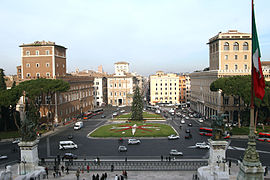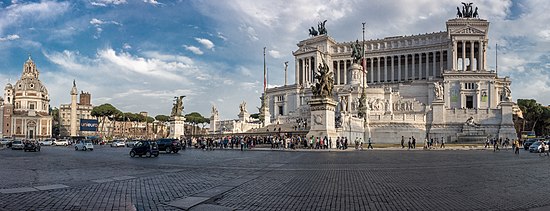Piazza Venezia | |
|---|---|
| City square | |
 Piazza Venezia, as seen from the Monument to Vittorio Emanuele II with Palazzo Venezia to the left | |
| Location | Rome, Italy |
 Click on the map for a fullscreen view | |
| Coordinates: 41°53′47″N 12°28′57″E / 41.8964°N 12.4825°E | |
Piazza Venezia (Italian: [ˈpjattsa veˈnɛttsja]) is a central hub of Rome, Italy, in which several thoroughfares intersect, including the Via dei Fori Imperiali and the Via del Corso. It takes its name from the Palazzo Venezia, built by the Venetian Cardinal, Pietro Barbo (later Pope Paul II) alongside the church of Saint Mark, the patron saint of Venice. The Palazzo Venezia served as the embassy of the Republic of Venice in Rome.
Square
[edit]
One side of the Piazza is the site of Italy's Tomb of the Unknown Soldier in the Altare della Patria, part of the Monument to Vittorio Emanuele II, first king of Italy.
The piazza or square is at the foot of the Capitoline Hill and next to Trajan's Forum. The main artery, the Via dei Fori Imperiali begins there and leads past the Roman Forum to the Colosseum.
Most tourists in Rome visit the Piazza Venezia, which is a short walk from several of Rome's best known sights, including the Roman Forum, Capitoline Hill, Palazzo Venezia, and the famous Pantheon.[1]
History
[edit]Capitalizing on this modern and ancient symbolism--and the useful open space--Piazza Venezia was the location of public speeches given by the Italian dictator Mussolini to crowds of his supporters in the 1920s-1940s.
Excavations
[edit]In 2009, during excavations in the middle of the square for the construction of the Rome C Metro Line (station Venezia), remains of the emperor Hadrian's Athenaeum were unearthed.[2][3]

References
[edit]- ^ https://famouswonders.com/piazza-venezia/ Piazza Venezia, Famouswonders, 2015.
- ^ Kington, Tom (December 26, 2012). "Hadrian's hall: archaeologists finish excavation of Roman arts centre". The Guardian. Retrieved December 26, 2012.
- ^ Unearthed in Rome’s New Subway: Extinct Elephants and Persian Peach Pits, The New York Times, December 18, 2017.
External links
[edit]- Lucentini, M. (31 December 2012). The Rome Guide: Step by Step through History's Greatest City. ISBN 9781623710088.
![]() Media related to Piazza Venezia (Rome) at Wikimedia Commons
Media related to Piazza Venezia (Rome) at Wikimedia Commons
| Preceded by Piazza di Spagna |
Landmarks of Rome Piazza Venezia |
Succeeded by Via dei Coronari |